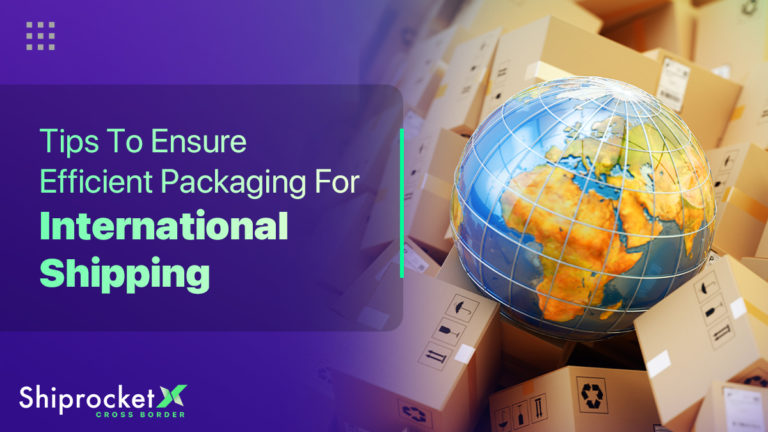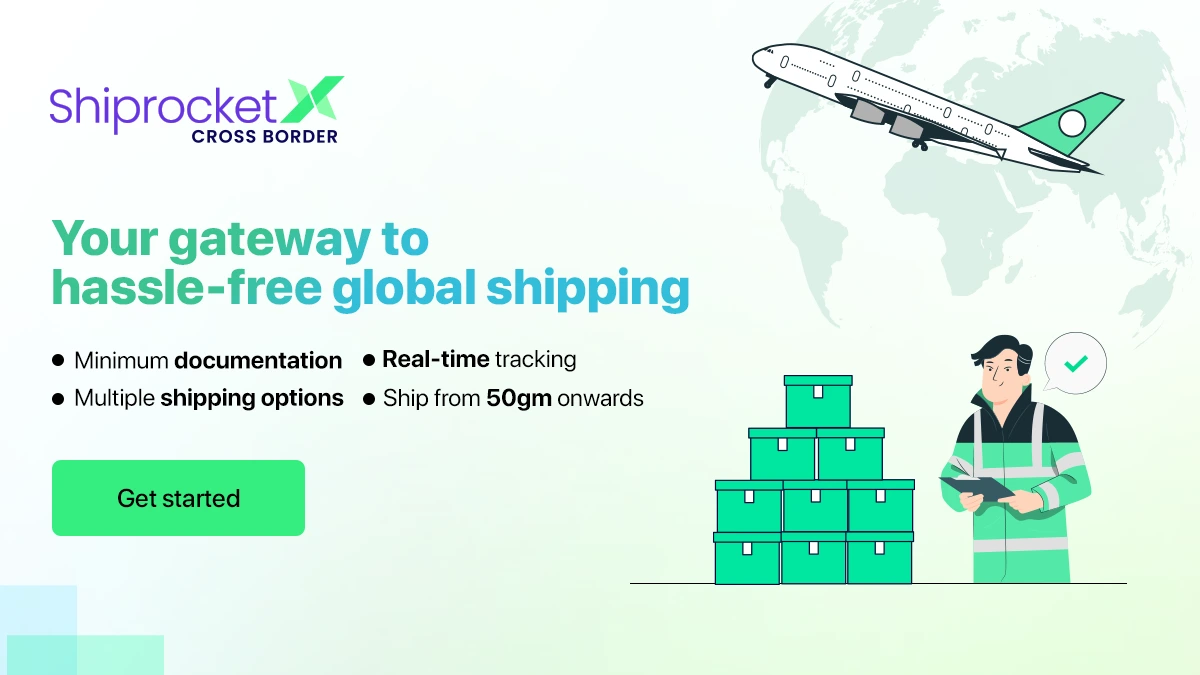Top Tips for Secure International Shipment Packaging
- Packaging Your Goods For International Delivery
- What is the Importance of International Shipment Packaging?
- Things To Consider While Packing An Overseas Shipment
- A Step-by-Step Guide to International Shipment Packaging
- How To Know If The Packaging Is Secure
- Types Of Packaging/Packaging Material Recommended For Use
- Top International Shipping Tips
- Role Of A Good Shipping Partner
- Conclusion
Packing goods for shipment in the ideal packaging material is necessary to create an everlasting impression on customers and to ensure the safety of the content. This will also help create a loyal customer base. Receiving international orders indicates that your firm is flourishing, which is excellent news. Your goods will, however, be in transit for longer and may require a little more protection to make it through the trip.
To make sure packaged goods reach the buyer undamaged, you must focus on how well they are packaged.

Packaging Your Goods For International Delivery
Overseas road freight is far more complicated than delivering domestically. One of the most important elements, the packaging, is essential to delivering secure, high-quality goods.
International deliveries often entail air or sea freight, which means goods and packaging must endure the rigours of transit.
Every company that ships goods abroad has to ensure that the packaged goods are securely confined in suitable packaging that is strong enough to withstand movement and pressure yet lightweight and space-efficient enough to be economical.
What is the Importance of International Shipment Packaging?
Here are some of the major benefits of international shipment packaging:
- It protects the shipment from any external damages.
- International shipping is cost-effective when planned and executed properly.
- It enhances your brand image in the international market.
- It reduces the environmental impact of shipping.
Things To Consider While Packing An Overseas Shipment
Some of the pointers for shipping packaged goods abroad are:
- Understand the Customs Regulations of the Destination Country
When shipping internationally, comprehending the customs regulations of the destination country is essential. Each country has its own set of rules and requirements regarding imported goods, like those relating to prohibited items, specific labelling requirements, and necessary documentation. For instance, while one country might ban certain goods, another might have unique requirements for food labels or textiles. Familiarise yourself with these regulations to avoid delays, fines, or shipment returns. Resources like the World Customs Organisation or the specific customs agency of the destination country can provide valuable insights and updates on these regulations.
- Make Sure Your Products Are Prepared To Withstand The Stress And Demands Of International Shipping
You must first verify the security of the transported products. In addition to safe packaging, the items must be able to endure the stresses of overseas transportation. Therefore, you need to be careful to position the items, so they do not get damaged.
This implies that you need to make sure your products can be stacked. Your items may be sent with a variety of other items. They must all be secured and able to be placed alongside, on top of, and against other items without being damaged.
- Verify The Permitted Size And Weight, And Use Proper Packaging
Your goods must adhere to the appropriate weight and dimension. The box or crate you choose for packaging must be able to support the whole weight of your product. If not, your products could be damaged while being shipped, especially if they are expensive, bulky items. People frequently have to endure great losses when the crates can no longer withstand the weight of the contents.
- Keep Internal Packaging And Taping In Mind
Use durable air-cushioned supports and foam peanuts to fill up the empty spaces in the boxes.
You may also employ the box-in-box technique to handle similar circumstances. A larger box with covered areas is used to house the item box within. H-taping, where the openings and edges are covered with tape, is also advised to prevent any damage during shipment and handling.
- Prioritize Protection Over Looks
Many eye-catching and vibrant baskets and sacks are available to entice buyers. Yet, shipping overseas entails transitional pauses, and sturdy packaging is advised. It would be best if you chose practicality above aesthetics to secure your assets.
Make sure the items are properly wrapped and taped up if you choose attractive packaging.
- Evaluate Customer Feedback
The most crucial thing to remember is to listen to your consumers. Consider making extra efforts to determine why your packing may not be effective and enhance it if consumers are complaining that their purchases are missing or damaged.
Ask consumers for feedback once they get their shipments or packages to determine if everything meets their expectations. It might save future hassles for your company and dissatisfied clients.
- Get Insurance Coverage for Your Shipment
Obtaining insurance coverage for your shipment is a smart way to protect your investment. While basic insurance may be included with many carriers, it might not cover the full value of high-cost or fragile items. Review the insurance options available and consider purchasing additional coverage if needed. This can protect your shipment against loss, damage, or theft during transit. Ensure all receipts and documentation related to your shipment are kept safe, as these will be necessary for any claims. Photographing your items before packing them can also provide evidence of their condition, which can be useful if a claim needs to be filed.
- Securing Your Package
Making sure your package is secure and will remain so until it reaches the customer is an essential part of the shipping process. In the case of international shipping, its relevance increases since the distance the package travels is greater. The following steps should be followed to secure your package and ensure it reaches the perfect condition.
To ensure your package is secure, choose the right size and type of box; it should be sturdy enough to withstand handling during shipping. Use high-quality packing materials such as bubble wrap, foam peanuts, or air pillows to cushion your items. Employ the box-in-box technique for added protection, where you place your items in a smaller box and then put that box within a larger one filled with cushioning materials. Seal all seams and edges with strong packing tape and reinforce the corners. Proper labelling, including ‘fragile‘ or ‘this side up’ instructions, ensures careful handling during transit.
- Select The Proper Box Size
To prevent the contents of your boxes from shifting while they are being transported, they should be packed firmly. Even large products should be packed in boxes that are nearly the same size. If you must use a box substantially larger than the item you are sending, fill up the space with safeguarding packaging materials.
- Avoid Overfilling
Although you should fill the whole capacity of the box you are sending, you shouldn’t stuff too much at once. The bottom may collapse and spill the contents.
Avoid overstuffing the boxes as they might cause the box to crack and cause damage to the contents.
A Step-by-Step Guide to International Shipment Packaging
International shipment packing is extremely critical to retain the quality of the goods. The following steps will act as a guide to ensure proper packing for international shipping:
- Gather Materials and Prepare Your Goods
The shipped parcel undergoes a whole chain before reaching the consumer. The parcel is handed down to the first-mile service providers, air freight personnel, customs authorities, last-mile partners, and many more. Hence, it is necessary to consider this while packing your products. Old or used boxes that do not have the strength for the type of product you intend on shipping can fall apart as it is passed through the chain. The packages can also rub against other parcels during the shipping journey. The friction between the parcels can damage the contents or packages. Hence, the packing must be sturdy.
Opting for low-quality materials for packing your shipments can weaken or break during delivery and result in box ruptures. The following factors must be considered while choosing how to package the product:
- The weight of your product: As the weight of the package increases, the packing strength must also increase. The manufacturer’s stamp can help you identify the strength of the box. Corrugated boxes and polyurethane bags can be chosen based on the weight of the package.
- Shape and size of your product: When you are using a box to pack an item, there must be enough space for cushioning material. The item should not touch the sides of the box.
- Fragility and value of the product: High-value goods and fragile items will need extra cushioning and protection. They must also be labelled with the fragile symbol on the parcel. When you ship an item that is not conventionally shaped or fragile, you can choose to pack it in a polyurethane bag with tissue.
- Fill and Seal the Box
Place all your goods in a box and fill the gaps with tissue, crumpled paper, or any cushioning material. In the case of fragile goods, you can wrap them in bubble wrap to ensure they are well-protected during transit. The key is to ensure that you do not overfill or underfill. This cushioning material absorbs shocks and vibrations during shipping, thereby protecting the parcels. Some materials to be used for cushioning include:
- Bubble wrap
- Airbags
- Cardboard inserts and foam
You must also consider the costs while cushioning to ensure your costs are not unaffordable due to the weight.
The right type of sealing tape should be used while packing your shipment. You can use adhesive strips and sealed bags to ensure it does not open up during transit. It should ensure that no dust or liquid enters the parcel. Avoid using straps and strings, as they can hamper the machinery used during shipping.
- Use Proper Labelling
Even if you’re moving from one place to another, you should always label your shipments. The shipping firm can guarantee the package reaches the destination based on proper labelling. Previous shipment information on reused boxes should be covered with black ink or removed.
- Weigh and Measure the Package
Weighing the packing is the next step during international shipping. You must also measure its dimensions to determine the shipping prices to ensure that all the requirements of the carrier are met. The costs will be based on the weight or the volumetric weight. Hence, the balance of packing and protection is crucial.
- Choose the Right Shipping Method
The shipping method chosen during international shipping will depend on:
- Speed
- Costs associated
- The location of the delivery
You must consider the above factors while choosing your shipping method. Air shipping ensures safe and quick shipping deliveries. However, it is more expensive than any other shipping method.
- Choose a Shipping Carrier
The choice of the shipping carrier also depends on your costs and budget. You can share or rent out the entire carrier based on your needs. You need to ensure that your carrier is also a reliable partner so that you do not need to worry during shipping.
- Ship the Package
The packed shipment is then taken to the carrier, or the shipping partner can pick it up based on the terms agreed upon. This is then put through the shipping process, and it finally reaches its destination.
How To Know If The Packaging Is Secure
It is essential to secure your items throughout shipping to guarantee that they arrive unharmed and that any person around the parcels while they are in transit is safe.
The following are ways in which you can ensure that your packaging is secure.
- Make Sure It Minimizes Damages
Packages experience a great deal of stress. They might drop from a forklift, a conveyor belt, or a pallet that has shattered. Delivering your goods to the consumer will cost more than twice as much if it is rendered useless due to a thoughtless error.
The secret is to pick durable materials that will shield your goods from harm. It would also help to consider how exposed a package is to the environment: severe temperatures, leaky roofs, and strong winds.
- It Should Provide Appropriate Cushioning
In packing, cushioning consists of loose material used between the products. Foam sheets, bubble-out bags, bubble wrap, and Styrofoam or biodegradable packing peanuts are a few typical types of cushioning.
To provide the best protection for fragile and collectable goods without breaking the bank, cushion the interior of the box by 3 inches.
- It Should Be Sealed Effectively
A strong seal on your packaging is also essential with a good cushion. All the protective padding in the world won’t help if your package should open in the middle of the journey.
Many sealants are available that will successfully keep your box closed.
Types Of Packaging/Packaging Material Recommended For Use
Your business will undoubtedly outperform competitors if you can optimize your packaging and prevent some of the frequent packaging errors. You can review the materials listed below to grasp your options better.
- Bubble Wrap
- Many different sizes and types of bubble wrap are available, but bubble bags are the most popular.
- They may also be found in rolls, which is convenient for wrapping goods in packaging boxes.
- They offer packing as well as protection.
- Packing Peanuts
- The size and form of packing peanuts are comparable to those of unshelled peanuts.
- Fragile items are frequently packaged with them in bunches in packaging boxes.
- As a filler, they safeguard delicate objects.
- They take advantage of open space and closely encircle the items to be guarded.
- Padded Divider Sets
- You can use sectioned, cushioned boxes called “padded sets” to organize shipping goods. These boxes offer cushioned coverings and surfaces on all four sides for increased support.
- Small walls separate them into sections.
- It is feasible to send two incompatible items in the same package using padded divider sets.
- Paper Wrapping
- Wrapping paper, often known as packaging paper, can be used in a variety of packaging applications.
- It comes in a range of colours and textures, such as brown paper, cartons, etc., and is considerably thicker and more durable than standard printer paper.
- It is often sold in rolls.
- To keep the paper in place, you might add tape or glue to the packed paper.
- Foam Packaging
- Many different materials may be cut and formed into shapes appropriate for different packaging boxes.
- Compared to others, this packaging material is bigger and denser. It is typically utilized for international shipping.
- It can bundle objects that lack a definitive form as per the packaging boxes.
- Its varieties include sheets, sponge rolls, foam rolls, and egg crates.
- You have a range of possibilities because several different types of foam are used in packing. It might be packaged collectively with the item.
Top International Shipping Tips
Let’s look at some of the most important points you should consider when shipping internationally.
- Determine Demand
You must conduct thorough research to determine if there is a substantial demand for your products in the international market. Prior requests from customers worldwide indicate a demand for your products in those regions. You will also require a well-planned strategy for entering new markets globally. You also need to understand your competitors before you enter a specific market.
- Lower Shipping Costs
The shipping costs are the significant costs associated with shipping products internationally. Shipping costs can bite into your profits. Hence, you must know how you can minimise your shipping costs. You must ensure that you negotiate with your customers to reduce the price as much as possible. Based on the courier you use, you can be charged for fuel surcharges, delivery signatures, etc., additionally. You must find ways to reduce international shipping costs.
- Choose the Right International Shipping Strategy
An international shipping strategy is crucial for giving your customers what they want while being cost-effective. While there is no norm for a strategy, you must consider the following while creating a strategy:
- The weight and size of your shipments
- Shipping destinations
- Specific shipping requirements
You must also manage your shipping choices to keep your costs under your budget.
- Protect Fragile Items
The right type of packing for the products being shipped is crucial. International shipping is long-distance shipping. Hence, it is essential to use appropriate packaging. Fragile items must be taken care of to ensure they are not damaged during shipping. The mode of transportation is also essential. The proper packing with the proper labelling is necessary.
- Use Commercial Invoices
Commercial invoices include the necessary details about the goods being shipped. It is also used during customs declaration. Commercial invoices are crucial during international shipping because:
- It is a mandatory legal requirement.
- It promises that the right taxes and duties are paid for the items.
- It provides the right details of the shipments, thereby eliminating the delays.
- Streamline Processes
The shipping process can be highly complicated and navigating through it can be challenging. Hence, streamlining this process is necessary. It makes the process more organised and eliminates uncertainty that can cause delays in shipping. You can employ different software tools for inventory management, order management, tracking processes, etc. These will help you eliminate manual errors that can slow down this process.
- Translation Services
You face various new cultures apart from regulations and laws when you ship internationally. Understanding the environment and culture of the region you are shipping to is essential for smooth operations and hassle-free international shipping of products. Language barriers and lack of cultural awareness can create challenges during the shipping phase. By employing native shipping services and translation services, you can eliminate these challenges.
- Choose the Right Shipping Service
There are a few critical factors to account for while choosing the right shipping service:
- Tracking services
- Delivery timelines
- Pricing
- Overall shipping costs
You must ensure all these criteria are met while choosing your service and service provider.
- Learn Shipping Terminology
Knowing the shipping terminology can help you gain more control over your shipping processes. You can keep the following in your mind:
- Commercial invoice
- Certificate of origin
- Duties and taxes
- Export declarations
- Harmonised tariff code
- Learn Shipping Restrictions
Several items fall under the restricted list in many countries, and hence understanding the restrictions of those countries is mandatory. In case you send a package with restricted items, they can be retained for long periods with the authorities. To save time and money, you must be familiar with the restrictions.
- Expect Longer Delivery Times
Overnight shipping is complicated when it is international shipping. Hence, delivery times will be longer. You will also need to tell your customers that overnight shipping is not possible. You must choose suitable shipping service in case your deliveries are time-sensitive. The terms must be well defined as international shipments are at risk of delays.
- Beware of Scams
Scammers are something that you must keep in mind. Even the most prominent companies deal with theft, robbery, and scams. You must take all the necessary measures to protect yourself from scammers.
- Calculate Shipping Tariffs
Shipping tariffs are an additional part of shipping rates. These are charges levied by shipping companies for international delivery of the products. Other freight charges also fall under this. This charge depends on the shipping company; hence, you must conduct proper research while choosing your shipping company.
Role Of A Good Shipping Partner
With all these aspects to be considered in international shipping, it is vital to engage the services of a reliable shipping partner. The type of shipping firm you select will determine how well your shipping partner fulfills all your needs.
With a shipping partner, you needn’t worry about major aspects of shipping. Hence it is usually a good idea to collaborate with a partner when managing international freight.
Reputable international shipping aggregators like ShiprocketX can completely optimise your supply chain and assist you in growing your company and beginning to export to more than 220 countries.
Conclusion
Selling and exporting your products worldwide benefits your company since it increases the number of customers. However, you must take great care while packaging your products to ensure that the buyers receive them undamaged. You can always win your client’s trust by undertaking appropriate measures and partnering with a reliable shipping partner.






